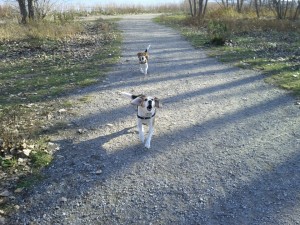A responsible and conscientious dog owner selects all their dog care professionals (veterinarian, trainer, groomer, etc.) with care. There is, however, one professional, that needs to be chosen more carefully than any. Yes, even over your dog trainer. That’s your dog walker.
Dog walkers spend a considerable amount of time with your dog. So much of the physical and mental well-being of your dog is dependent on how your dog walker operates his or her business and what their knowledge of dog behavior is like. Unfortunately, many dog walkers that I see would not meet my expectations – I would not put my own dogs in the care of most of the dog walkers I see out there.
I have the luxury of working mostly evenings and weekends – so I take my boys out for walks during the same hours that most dog owners are at work. I walk amongst the dog walkers. I’m often confused for them.
In recent months, some of the things I’ve witnessed include:
– Constant leash corrections – I was picking up Chase (the Jack Russell that I was training for eTalk) and in the span of just a thirty second elevator ride with a dog walker, I counted twenty leash corrections on a Golden Retriever puppy that must have only been 14 weeks old. All the dog was doing was sniffing, or looking around. By the end of the week, if you extrapolate that, that puppy will have received approximately 2000 leash corrections – and not once been taught what to actually do (how about asking the puppy to sit?)
– Violent “alpha rolling” – at Cherry Beach I witnessed a dog walker tackle and then sit on a Chocolate Lab. The dog walker must have been around 200 lbs in weight. Besides creating a dog that is afraid of people/physical touch, that kind of crushing weight can break bones or at minimum cause stress and damage to the spine.
– Bored, unexercised dogs – I see dog walkers that take their groups to the same boring concrete tennis court day in, day out. The dogs don’t even move anymore. They just sit there bored out of their mind. Mentally unstimulated, physically unexercised. What a waste. The worst offender I’ve seen is a dog walker that takes a group of dogs on a leash walk around a 400 meter oval track round and round for an hour – it’s the saddest group of dogs I’ve ever seen.
– Related to boredom – wandering dogs. I go to the dog park armed with amazing treats and squeeky balls, and I’ve worked hard to pump up my dogs’ motivation for toys. They fetch. They chase me down when I hide or run away. Often, a “stray” dog from a dog walker’s group will notice us having so much fun and latch on and try to hang out with us. I’ve left Cherry Beach and headed to the parking lot and have had dogs follow me out – dog walker nowhere to be seen.
Bored dogs at off leash dog parks make their own fun. If they’re not chasing balls or sticks or moving around, I’m fairly certain they’ll end up bothering other owners and other dogs. That’s how inappropriate play, bullying, and eventually fighting breaks out. Dogs that are subjected to physical punishment, especially when delivered by the unskilled hands of a dog walker (you can’t possible time punishment correctly if you’re in charge of six dogs) will eventually develop fear and aggression. In both cases I would rather see the dog stay at home for nine hours a day.
But, enough with the negative! There is hope… there are good dog walkers out there. They are in the minority so I hope you are lucky enough to have one. Last summer, I tagged along with Julie (she is a dog walker by day, and has two employees that walks dogs for her as well) because I wanted to learn a bit about what good dog walkers do, and also improve my own skills in handling multiple dogs at once off leash. I brought my video camera and here’s a montage of what a brilliant group dog walk should look like:
Good dog walkers:
- Bring treats. Every day these people are with your dog for about two hours. There are many opportunities where your dogs will do something brilliant – that behavior should be reinforced, so it is repeated. Julie reinforces dogs for making good choices – especially recall.
- Get them hooked on fetch. Three great things come from fetch. Gives physical exercise, conditioning a new reinforcer (dogs that’ll do anything for the ball to be thrown), and keeps them busy and out of trouble.
- Keep moving. No sitting on a park bench checking text messages, while your dog harasses other dogs due to boredom and causes fights.
- Consider mental stimulation. A leash walk around and around the same block is about as exciting as going on a treadmill, as is going to the same fenced in box five days a week. Your dog walker should mix it up regularly.
- Pay attention and avoid problems. Strange dog with testicles on a pinch collar hard staring at your dogs coming this way? Recall your dogs and move away quickly. Every other person and dog is a potential risk that requires assessment and the best solution to problems is to avoid them altogether.
- Realize they’re not a dog trainer. Julie is, but most aren’t. I recently received an email from a great dog walker I know. She included her client, and described her dog’s recent displays of aggression, and asked for help. A professional knows their limits.
If you’re considering a dog walker, or currently have one, ask hard questions and get good answers. A bad choice – your dog will suffer and you will see the behavioural fallout. A good choice – you’ll see countless benefits, such as improved off-leash recall and a tired, relaxed dog.

